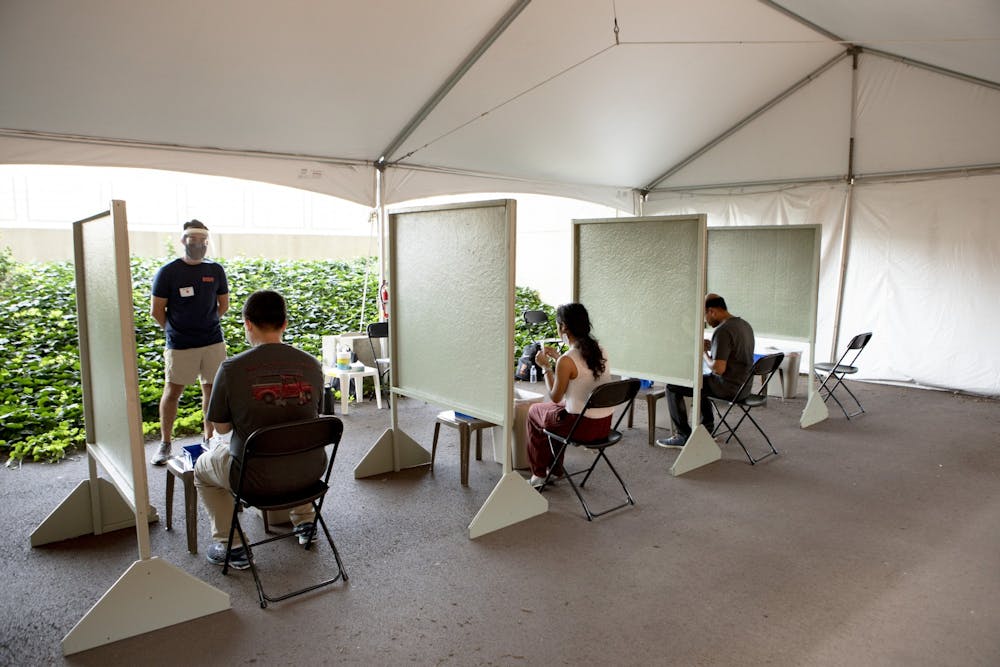Last week, the University debuted a COVID-19 Dashboard on its official Fall 2020 website. The dashboard reports that 14 University community members have tested positive since the beginning of the semester. No new cases were reported within the past week.
The comprehensive database offers a weekly overview of the number of COVID-19 tests conducted by University Health Services (UHS) on both asymptomatic and symptomatic students, faculty, and staff. It also reports various isolation and quarantine statistics.
The COVID-19 dashboard data from Aug. 23 to Sept. 18 indicates that the rate of positive cases among graduate students has barely fluctuated over the four-week period. On average, the dashboard documented about one positive case each week.
In the week ending on Sept. 18, three asymptomatic graduate students tested positive for the coronavirus. No undergraduate students have tested positive this semester.
University Executive Director of Environmental Health and Safety Robin Izzo said the COVID-19 dashboard allows the Princeton community “to compare one week to the next week, which helps us [UHS] to determine whether there are any mitigation strategies or whether we should be considering any changes.”
The University has adhered to a bi-weekly testing protocol for students on campus and weekly testing for faculty. Approximately 300 undergraduate students are living on campus this fall, while the graduate student body and faculty consists of about 4,000 individuals.
In addition to these efforts, the University has enforced strict social distancing guidelines in an effort to mitigate the spread of COVID-19.
Daniel Duncan ’24, a student living on campus this semester, said that students on campus have been following social distancing guidelines.
“We’ve been mindful,” he said. “Of course, sometimes it’s difficult to adhere [to the guidelines] 100 percent, but for the most part, we’ve been doing our parts by having our face masks on, staying six feet apart, washing our hands, and using hand sanitizer when necessary.”
The primary COVID-19 test that the University uses is a PCR (polymerase chain reaction) saliva test.
Irini Daskalaki, the Global Health and Community Physician and Pediatric Infectious Disease Specialist at UHS, noted that the University might soon obtain new rapid tests for symptomatic testing.
“Pretty soon, we’re expecting to have rapid PCR tests on site, so you can have same-day results for symptomatic students,” she said.

Daskalaki expects that these new tests will yield results in a span of about 45 minutes, a significant improvement over the two-to-three day waiting period that the current test requires.
The University’s asymptomatic testing protocol has evolved over the past week to render the process more efficient while ensuring the health and safety of the campus community.
According to UHS Director Janet Finnie ’84, the testing team has incrementally decentralized the testing process in order to make it more convenient. She recounted that students were previously required to receive swab tests at the University Stadium Concourse.
“We are moving people onto decentralized testing, where they perform the sample on their own and they drop the specimen in a drop box, somewhere around campus,” Finnie said.
“[People] would rather just do the test, drop it in the bin — not have to schlep over to the stadium,” she said.
Looking forward, UHS is preparing to manage COVID-19 during flu season.
“There is no way to differentiate between the flu and COVID-19 clinically,” said Daskalaki. “So there’s going to be more testing.”
Finnie encouraged all undergraduate students to acquire their flu vaccines before the annual flu season arrives.
“We are asking graduate and undergraduate students to document that [they have received the flu vaccine], and part of the reason for that is because we’re hopeful that a class or more will come back in the spring,” she said.
Finnie urged local students, faculty, and staff to take advantage of the upcoming FluFest in Jadwin Gymnasium.
Editor’s Note: This story originally stated that the University primarily uses a “saliva test” rather than a “swab test.” The ‘Prince’ regrets the error.








